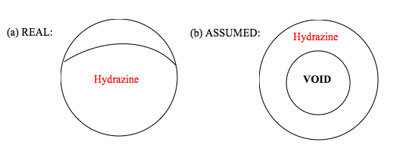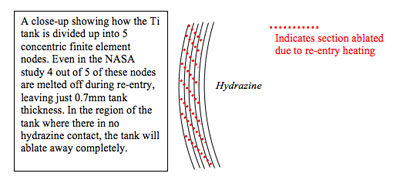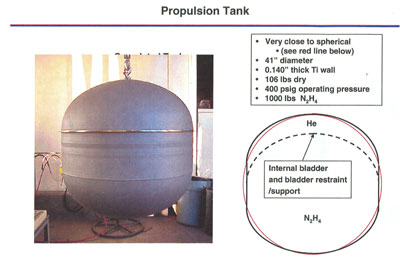On the technical study of USA 193’s fuel tank reentryby Yousaf Butt
|
 |
Why is the idealized case studied in the report a gross oversimplification? The frozen hydrazine acts as a heat sink, and in reality this “heat sink” is missing over a large fraction of the tank, as shown in (a) above. This makes the tank susceptible to ablative burn-through in any region not in contact with the hydrazine. Although the hydrazine may melt and be repositioned during re-entry, it cannot assume the unphysical assumed distribution shown in (b) above, and cannot cover 100% of the interior of the tank, given that the tank was just 76% full to begin with.
The tank would have ablated through, at least partially, at roughly 48 kilometers altitude. Subsequent to that, at about 33 kilometers altitude it would have suffered peak dynamic pressure, which would have breached the tank completely and dispersed the then liquefied and slush contents high up in the atmosphere with negligible risk to anyone on Earth.
(NASA administrator Michael Griffin mentioned in a February 14 2008 press briefing that his agency’s best simulations indicated that subsequent to the re-entry heating of the hydrazine tank that the hydrazine would be in slush form. “[Y]ou will land on the ground with a tank full of slush hydrazine that would then later evaporate.” The released NASA study mentions “Using the mass of 453.6 kg, and the assumed heat capacity of 1559.45 J/kg-K, the N2H4 would have needed to absorb 43.15 MJ of energy to reach 275 K from the start temperature of 214 K. It only absorbed 29.34 MJ, or about 68% of that.” Clearly a more realistic initial temperature of hydrazine (~260 K) would have led to a greater melted mass, consistent with Mr. Griffin’s statement. The authors of the NASA report in fact agree that their “dictated” temperature is too low: “The initial temperature of the tank and the N2H4 was dictated to be 214 K for this study, although the actual temperature would very likely be higher.”)
| If there are any US government studies that indicate that the tank would have survived reentry, the government ought to dig those studies out of obscurity and present them to the US public who actually funded the studies. |
Talking about risk numbers only makes sense if the tank would have made it down intact with its load of hydrazine. But even in the NASA study, in the intimately heat-sunk hydrazine contact region, four out of five finite-elements are ablated away (see figure below). In the non-heat sunk regions the tank melts away completely. The NASA ORSAT (Object Reentry Survival Analysis Tool) and ESA SCARAB (Spacecraft Atmospheric Reentry and Aerothermal Breakup) computer modeling codes actually agree on this. Had the NASA simulation used a finer finite-element grid—e.g. 20 finite-elements—then 19 would have ablated away leaving nothing but a foil thickness, and that only in the hydrazine heat-sunk region. The rest of the tank will have burnt up completely with certainty. (The only finite element node to survive will be the one that is directly heat-sunk to the hydrazine, whose modeling was itself incorrect in the NASA study.)
An independent analysis of the same NASA paper by Dr. Geoffrey Forden of MIT reaches the same conclusion as myself and other colleagues do: the tank and hydrazine burn and disperse high up in the atmosphere.
 |
Jim Oberg concludes in his commentary:
The media has widely portrayed the project as aggressive and militaristic, an excuse to threaten China, and a backdoor gimmick to test “space weapons”. As a result, a well-defined and thoroughly-researched technological hazard assessment—one that it may be hoped should not ever be needed again, but could well be—has wound up buried in obscurity and obfuscation.
The only reason the hazard assessment has wound up buried in obscurity and obfuscation is that, according to a NASA official involved with the studies, the US government has imposed a gag order on NASA. If there are any US government studies that indicate that the tank would have survived reentry, the government ought to dig those studies out of obscurity and present them to the US public who actually funded the studies. The released NASA report indicates that there would have been no exceptional danger of death or injury from the hydrazine tank.
